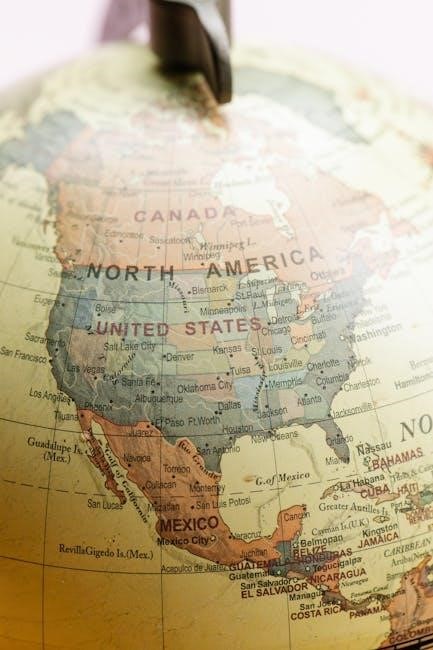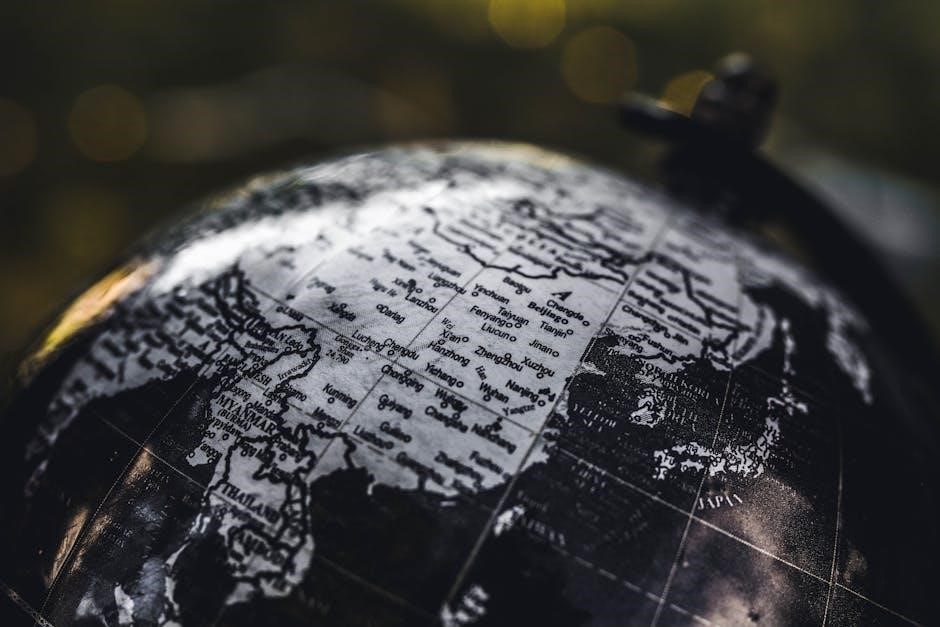World War II (1939–1945) was a global conflict involving the Axis powers (Germany, Italy, Japan) and the Allies (Britain, France, the U․S․, Soviet Union)․ It remains history’s deadliest conflict, shaping modern geopolitics and societies forever․
1․1․ Definition and Scope of World War II
World War II (1939–1945) was a global conflict involving the Axis powers (Germany, Italy, Japan) and the Allied powers (the United States, Great Britain, France, and the Soviet Union)․ It was the deadliest conflict in human history, with over 70 million fatalities․ The war encompassed Europe, Africa, Asia, and the Pacific, involving more than 100 million people from over 30 countries․ It was characterized by total warfare, including aerial bombings, naval battles, and ground combat․ The conflict’s scope extended beyond military engagements, impacting civilians through genocide, forced labor, and economic devastation․ It remains the most widespread and destructive war in global history․
1․2․ Importance of Studying World War II
Studying World War II is crucial for understanding its profound impact on global politics, society, and human rights․ It provides insights into the dangers of authoritarianism, nationalism, and racial hatred․ Analyzing the war’s causes and consequences helps prevent future conflicts by learning from past mistakes․ Additionally, it highlights the importance of international cooperation and diplomacy․ The war’s technological advancements and social changes, such as women’s roles in the workforce, shaped modern society․ Understanding these aspects fosters empathy for victims and survivors, particularly of the Holocaust․ By examining leadership decisions and their consequences, we gain valuable lessons in ethics and governance․ This knowledge remains essential for fostering peace and stability in the modern world․
1․3․ Key Dates: 1939–1945
World War II began on September 1, 1939, when Nazi Germany invaded Poland, prompting Britain and France to declare war․ Key events include the Battle of Britain in 1940, Germany’s invasion of the Soviet Union in 1941, and the U․S․ entry after Pearl Harbor in December 1941․ The D-Day invasion of Normandy on June 6, 1944, marked a turning point․ The war in Europe ended on May 7, 1945, with Germany’s surrender․ Japan surrendered on August 15, 1945, following the atomic bombings of Hiroshima and Nagasaki, officially ending the war on September 2, 1945․

Causes of World War II
Aggressive nationalism, economic instability, and the rise of fascist ideologies in Germany, Italy, and Japan fueled tensions, leading to the outbreak of World War II․
2․1․ The Treaty of Versailles and Its Impact
The Treaty of Versailles (1919) ended World War I but imposed harsh penalties on Germany, including heavy reparations and territorial losses․ This fueled economic hardship and national resentment, creating fertile ground for Adolf Hitler’s rise to power․ The treaty’s “war guilt clause” humiliated Germany, fostering a desire for revenge and rejuvenation․ Economic instability and hyperinflation in the 1920s further destabilized the country, enabling extremist ideologies like Nazism to gain traction․ The treaty’s failure to establish a lasting peace contributed significantly to the outbreak of World War II, as Germany sought to overturn the Treaty’s terms and restore its dominance․
2․2․ Rise of Fascist and Nationalist Ideologies
The rise of fascist and nationalist ideologies in the 1920s and 1930s played a pivotal role in the outbreak of World War II․ Leaders like Adolf Hitler in Germany, Benito Mussolini in Italy, and militarist leaders in Japan promoted aggressive nationalism, racial superiority, and authoritarian rule․ These ideologies emphasized the need for territorial expansion, military strength, and the suppression of dissent․ Hitler’s Nazi regime, for instance, sought to create a “pure” Aryan race and expand Germany’s territory, while Japan pursued dominance in Asia․ Such extreme ideologies fostered an environment of aggression and competition, ultimately leading to the invasion of neighboring countries and the escalation of global conflict․
2․3․ Policy of Appeasement
The policy of appeasement, pursued by Britain and France, involved giving in to Germany’s demands to avoid war․ This strategy was evident in the 1938 Munich Agreement, where Britain and France allowed Germany to annex the Sudetenland in Czechoslovakia․ The hope was that satisfying Hitler’s demands would prevent further aggression․ However, appeasement emboldened Nazi Germany, leading to the invasion of the remainder of Czechoslovakia and, eventually, Poland in 1939․ This approach ultimately failed to prevent World War II, as it only delayed the inevitable conflict and allowed Germany to strengthen its military capabilities․ The policy is widely criticized as a failed attempt at diplomacy․
2․4․ Economic Instability of the 1930s

The global economic crisis of the 1930s, known as the Great Depression, severely impacted nations worldwide․ High unemployment, industrial decline, and financial collapse destabilized societies, fostering resentment and extremist ideologies․ In Germany, hyperinflation and economic hardship led to widespread poverty, creating fertile ground for Adolf Hitler and the Nazi Party to rise to power․ Similarly, economic struggles in Japan and Italy contributed to militaristic and expansionist policies․ The collapse of international trade and the gold standard exacerbated tensions, while governments’ inability to address the crisis eroded public trust in democratic systems․ This economic instability played a crucial role in setting the stage for World War II․

Major Events of World War II
Key events include the Invasion of Poland (1939), Battle of Britain (1940), Pearl Harbor (1941), D-Day (1944), and atomic bombings of Hiroshima and Nagasaki (1945)․
3․1․ Invasion of Poland (1939)
The invasion of Poland by Nazi Germany on September 1, 1939, marked the official start of World War II․ Germany, under Adolf Hitler, sought to reclaim territories lost after World War I․ The invasion was swift and devastating, employing the “blitzkrieg” tactic, which combined air and ground forces to overwhelm Polish defenses quickly․ This act of aggression prompted Britain and France to declare war on Germany on September 3, 1939, escalating the conflict into a global war․ The Soviet Union also invaded Poland from the east on September 17, further dividing the country under the Nazi-Soviet Pact․ Poland’s resistance was short-lived, and by October 1939, the country was fully occupied, setting the stage for further European conquests by the Axis powers․
3․2․ The Battle of Britain (1940)
The Battle of Britain, fought from July to October 1940, was a pivotal aerial campaign between the Royal Air Force (RAF) and the German Luftwaffe․ Hitler sought to gain air superiority to invade Britain, codenamed Operation Sea Lion․ The Luftwaffe targeted British airfields, radar stations, and cities, but the RAF, supported by radar technology and effective command systems, successfully repelled the attacks․ The battle marked a turning point as Nazi Germany’s first major defeat, preventing a potential invasion and boosting British morale․ By October 1940, the Luftwaffe shifted to nighttime bombing, known as the Blitz, but the RAF’s resilience ensured Britain’s survival as a key Allied power․
3․3․ Operation Barbarossa (1941)
Operation Barbarossa, launched on June 22, 1941, was Nazi Germany’s invasion of the Soviet Union during World War II․ It marked a significant escalation of the conflict, as Germany sought to capture vital resources, territory, and eliminate communism․ The operation involved over three million German troops and was the largest military invasion in history․ Initially, the Soviets were caught off guard, leading to rapid German advances․ However, the harsh Russian winter and strategic errors by Hitler slowed the offensive․ The campaign resulted in massive casualties on both sides and ultimately failed to achieve its objectives, weakening Germany’s position on the Eastern Front․

3․4․ Attack on Pearl Harbor (1941)
The Attack on Pearl Harbor occurred on December 7, 1941, when Imperial Japan launched a surprise military strike against the United States naval base in Hawaii․ The assault, intended to prevent the U․S․ Pacific Fleet from interfering with Japanese expansion in Southeast Asia, caught American forces off guard․ The attack destroyed or damaged numerous ships, including eight battleships, and resulted in over 2,400 American casualties․ The bombing led to the United States’ formal entry into World War II, declaring war on Japan the following day․ This pivotal event reshaped the global conflict and marked the beginning of the Pacific War․

3․5․ D-Day and the Normandy Landings (1944)
On June 6, 1944, Allied forces launched Operation Overlord, the largest amphibious invasion in history, landing on five beaches in Nazi-occupied Normandy, France․ Over 156,000 troops from the United States, Britain, Canada, and other Allied nations stormed the heavily fortified German defenses․ Despite significant casualties, the Allies successfully established a foothold, marking a turning point in World War II․ The Normandy Landings opened a new front in Western Europe, accelerating the liberation of France and contributing to the eventual defeat of Nazi Germany․ This operation demonstrated unparalleled coordination and sacrifice, forever etching D-Day in the annals of military history․
3․6․ Atomic Bombings of Hiroshima and Nagasaki (1945)
The atomic bombings of Hiroshima (August 6, 1945) and Nagasaki (August 9, 1945) marked the first and only use of nuclear weapons in warfare․ The U․S․ dropped “Little Boy” on Hiroshima and “Fat Man” on Nagasaki, causing unprecedented destruction․ An estimated 140,000 people died in Hiroshima and 80,000 in Nagasaki by the end of 1945, with many more succumbing to radiation sickness later․ These bombings led to Japan’s surrender on August 15, 1945, ending World War II․ The events remain a pivotal and controversial moment in history, highlighting the devastating consequences of nuclear warfare and shaping global geopolitics․

Key Battles and Campaigns
World War II saw numerous pivotal battles that shaped its outcome․ Major conflicts included Stalingrad, El Alamein, Midway, Kursk, the Bulge, and the Fall of Berlin․
4․1․ The Battle of Stalingrad (1942–1943)
The Battle of Stalingrad, fought between August 1942 and February 1943, was a pivotal confrontation during World War II․ It involved the Soviet Red Army clashing with Nazi German forces in a brutal urban conflict․ The battle was marked by intense street fighting, heavy casualties, and a devastating siege that trapped the German Sixth Army․ The Soviet counteroffensive, led by General Georgy Zhukov, ultimately encircled and forced the surrender of the German forces․ This victory marked a major turning point on the Eastern Front, halting Nazi advances and shifting momentum in favor of the Allies․ The battle resulted in over a million casualties and significant material losses․

4․2․ The Battle of El Alamein (1942)
The Battle of El Alamein, fought from July to November 1942, was a decisive confrontation in North Africa during World War II․ British forces, led by General Bernard Montgomery, clashed with Erwin Rommel’s Axis troops in a battle that marked a turning point in the war․ The Allies’ superior logistics, intelligence, and coordination enabled them to repel the Axis advance and launch a successful counteroffensive․ The victory at El Alamein halted Axis expansion in Africa and boosted Allied morale, paving the way for the eventual liberation of the continent․ It remains one of the most significant battles in the North African Campaign․
4․3․ The Battle of Midway (1942)
The Battle of Midway, fought from June 4 to 7, 1942, was a pivotal naval engagement in the Pacific Theater of World War II․ It occurred near the Midway Atoll, a strategic U․S․ outpost, and involved aircraft carriers from both the United States and Japan․ The U․S․ Pacific Fleet, aided by intelligence on Japanese plans, launched a preemptive strike, sinking four Japanese carriers and one heavy cruiser․ Japan lost hundreds of experienced pilots and crew, crippling its naval air power․ The U․S․ victory halted Japanese expansion and shifted momentum in the Pacific, marking a turning point in the war․ This battle showcased the importance of naval aviation and intelligence in modern warfare․
4․4․ The Battle of Kursk (1943)
The Battle of Kursk, fought from July to August 1943, was the largest tank battle in history, occurring near the Soviet city of Kursk․ It was a German offensive aimed at weakening the Soviet defenses, but the Soviets, anticipating the attack, built extensive fortifications․ The clash involved thousands of tanks and aircraft, with the Soviets employing innovative tactics like mobile armored reserves․ Despite initial German gains, Soviet counterattacks repelled the advance, leading to a decisive Soviet victory․ This battle marked a turning point on the Eastern Front, as the Soviet Union gained the initiative and began pushing German forces back towards their borders, never to regain offensive momentum in the East․
4․5․ The Battle of the Bulge (1944–1945)
The Battle of the Bulge, fought from December 1944 to January 1945, was Germany’s last major offensive in World War II․ Launched through the Ardennes forest, it aimed to split Allied forces and capture the vital port of Antwerp․ The German army made initial gains, creating a “bulge” in Allied lines, but faced severe logistical challenges and fierce resistance․ As Allied forces regrouped and counterattacked, supported by superior air power, the German advance stalled․ The battle resulted in heavy casualties for both sides, but particularly depleted Germany’s resources, hastening their defeat․ It marked the final significant German offensive on the Western Front․
4․6․ The Fall of Berlin (1945)
The Fall of Berlin occurred in April–May 1945, marking the final stages of World War II in Europe․ Soviet forces launched a massive offensive, encircling the city and engaging in fierce street battles․ Adolf Hitler, realizing the end was near, committed suicide in his bunker on April 30․ German forces surrendered unconditionally on May 7, 1945․ The fall of Berlin symbolized the collapse of Nazi Germany and the end of the Third Reich․ The city suffered extensive destruction, and civilian casualties were immense․ This event was pivotal in ending the war in Europe, leading to the Allied victory and the subsequent occupation of Germany by the Allied powers․

The Holocaust and Genocide
The Holocaust was the systematic extermination of six million Jews and millions of others during World War II, carried out by the Nazi regime in concentration camps․
5․1․ Adolf Hitler and the Final Solution
Adolf Hitler, the leader of Nazi Germany, was the driving force behind the Holocaust․ His ideologies of racial purity and anti-Semitism led to the systematic extermination of Jews․ The “Final Solution,” formalized in 1942, aimed to eliminate Jews through mass murder․ Hitler’s regime implemented this plan through concentration camps, where millions were tortured and killed․ The Wannsee Conference in 1942 organized the logistics of genocide․ Hitler’s leadership and ideology were central to the Holocaust, making him responsible for one of history’s darkest atrocities․ His actions resulted in the deaths of six million Jews and millions of others, leaving a lasting impact on humanity․
5․2․ Concentration and Extermination Camps
Concentration and extermination camps were central to the Holocaust, serving as sites for mass imprisonment, forced labor, and genocide․ Auschwitz, Treblinka, and Buchenwald were among the most notorious․ These camps were designed to systematically execute millions, primarily Jews, through gas chambers and other brutal methods․ Conditions were inhumane, with overcrowding, starvation, and disease prevalent․ The camps symbolized the Nazi regime’s industrialized approach to genocide․ Allied forces liberated these camps in 1944–1945, exposing the full horror of the Holocaust․ These sites remain powerful reminders of humanity’s darkest chapter and the atrocities committed during World War II․
5․3․ Impact on Jewish and Minority Populations
The Holocaust devastated Jewish communities, with approximately six million Jews systematically murdered by the Nazis․ Minority groups, including Romani people, disabled individuals, and political dissidents, also faced brutal persecution; The Nazi regime’s racial ideologies fueled these atrocities, aiming to eliminate those deemed undesirable․ Jewish populations across Europe were disproportionately targeted, leading to the near-destruction of entire communities․ The trauma endured by survivors and the loss of cultural heritage had lasting effects․ Additionally, minority groups suffered immense losses, highlighting the broader scope of Nazi genocide․ The war’s end brought some justice, but the scars on these populations remained indelible․

Outcomes and Aftermath
The aftermath of World War II saw the defeat of Axis powers, establishment of the United Nations, and the emergence of the Cold War․ The Yalta and Potsdam Conferences reshaped Europe, while the Nuremberg Trials addressed war crimes, promoting accountability and justice․
6․1․ Yalta and Potsdam Conferences
The Yalta Conference (February 1945) and Potsdam Conference (July–August 1945) were pivotal post-war meetings․ At Yalta, Allied leaders (Roosevelt, Churchill, Stalin) agreed on dividing Europe into spheres of influence, reorganizing Poland, and Soviet involvement in the Pacific․ Potsdam focused on Germany’s denazification, demilitarization, and reparations․ The Potsdam Declaration demanded Japan’s unconditional surrender, leading to the atomic bombings․ These conferences laid the groundwork for the post-war world order, establishing the framework for the Cold War and shaping global geopolitics for decades․
6․2․ Division of Europe and the Cold War
The end of World War II led to the division of Europe into Eastern and Western blocs, sparking the Cold War․ The Iron Curtain, a term popularized by Churchill, symbolized the ideological and physical separation․ The Soviet Union dominated Eastern Europe, establishing Communist regimes, while Western Europe aligned with the United States․ The Marshall Plan revitalized Western economies, contrasting with the Soviet-controlled Eastern Bloc․ Tensions escalated with the formation of NATO (1949) and the Warsaw Pact (1955), solidifying the division․ This ideological and geopolitical split shaped global politics for decades, fostering proxy wars, espionage, and an arms race․
6․3․ Nuremberg Trials and War Crimes
The Nuremberg Trials (1945–1946) were landmark proceedings prosecuting top Nazi officials for war crimes, crimes against humanity, and genocide; Conducted by the Allies, these trials established the principle of accountability for atrocities․ Key defendants included Hermann Göring, Rudolf Hess, and Joachim von Ribbentrop․ The trials revealed horrifying details of the Holocaust and Nazi aggression․ The verdicts set a legal precedent, influencing international law and future tribunals․ Twelve defendants were sentenced to death, while others received prison terms․ The trials marked a significant step toward justice and served as a foundation for modern human rights frameworks․
World War II reshaped global politics, economies, and societies․ Its lessons remain crucial for understanding international relations, diplomacy, and the prevention of future conflicts․
7․1․ Legacy of World War II
World War II left a profound legacy, reshaping global geopolitics, economies, and societies․ It led to the establishment of the United Nations to promote peace and cooperation․ The war’s atrocities, particularly the Holocaust, prompted significant advances in human rights and genocide prevention․ The conflict also spurred technological innovation, such as computers and jet engines, and accelerated decolonization, leading to independence for many nations in Africa and Asia․ Additionally, it cemented the U․S․ and Soviet Union as superpowers, setting the stage for the Cold War․ The war’s economic impact led to the Bretton Woods system, shaping global financial structures for decades․
7․2․ Lessons Learned and Historical Significance
World War II imparted critical lessons about diplomacy, nationalism, and human rights․ It highlighted the dangers of unchecked aggressive ideologies and the importance of early intervention․ The war underscored the need for international cooperation, as embodied in the United Nations, to prevent future conflicts․ Historically, it marked the emergence of the U․S․ and Soviet Union as superpowers, setting the stage for the Cold War․ The Holocaust serves as a stark reminder of the consequences of hatred and prejudice, leading to global efforts to protect human rights․ The war also spurred technological advancements and social changes, reshaping the world’s political and cultural landscapes irreversibly․
